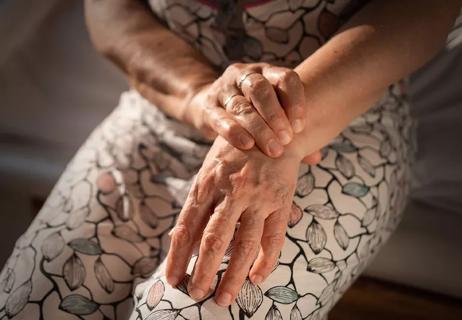Yes, your genetic makeup may increase your risk of developing arthritis, but other factors like age and weight can play a role, too

Your family history can determine features like your height, your hair color and even your eye color. But your genetic makeup can also contribute to your risk of developing certain medical conditions such as breast cancer and diabetes.
Advertisement
Cleveland Clinic is a non-profit academic medical center. Advertising on our site helps support our mission. We do not endorse non-Cleveland Clinic products or services. Policy
And if you or a family member have been dealing with arthritis and symptoms like joint pain, stiffness and inflammation, you may wonder: Is arthritis hereditary?
“We know that there is a genetic component to most types of arthritis,” says rheumatologist Lia Jamian, MD.
While your genetic makeup may play a role, there are also other risk factors and causes to consider. That means that if you have arthritis, you won’t necessarily pass it on to other family members — and if you have a family member with arthritis, that doesn’t automatically mean you’ll develop arthritis.
Dr. Jamian explains what common types of arthritis come with an inherited risk and how you can lower your chances of arthritis.
There are more than 100 types of arthritis, and there’s likely a hereditary component to all of them. But the genetic risk varies and is considered the highest if a first-degree relative (parent or sibling) has arthritis.
Dr. Jamian discusses some of the most common forms of arthritis and their genetic implications.
Easily the most common form of arthritis, osteoarthritis can cause inflammation and damage to joints when cartilage that covers the ends of bones degenerate.
“There are hereditary forms of osteoarthritis that are caused by mutations in genes for collagen,” says Dr. Jamian.
Advertisement
This type of osteoarthritis can first appear at a young age, quickly causing severe damage; though, it’s not very common. Around 40% to 65% of osteoarthritis has a genetic component, with a stronger link for hand and hip cases. Dr. Jamian says that there isn’t a singular gene that causes cases of osteoarthritis.
“Multiple genes are involved,” she notes. “The influence of other factors, such as obesity, joint injuries, aging and joint anatomy, is also quite substantial.”
Genetic factors are more strongly linked to cases of rheumatoid arthritis (RA). Classified as an autoimmune disease, RA primarily targets the lining of joints, mistakenly attacking the healthy tissue instead of damaged tissue.
Some environmental factors — such as infection, injury or smoking — can trigger immune system response in genetically susceptible people. In addition, there are more than 100 genes that may be linked to RA and the damaging effects on the immune system.
This type of arthritis causes inflammation in the spinal joints. Approximately 90% of people with ankylosing spondylitis (AS) carry a gene named HLA-B27.
Detected by a laboratory test, Dr. Jamian warns that a positive test by itself isn’t diagnostic.
“Not everyone with the gene gets AS, and some people without the gene develop it,” she clarifies.
Biological family history also plays a role in your susceptibility. People who have a family member with AS are more likely to develop the disease compared with those without the gene and no family history.
An inflammatory form of arthritis, gout causes pain and swelling in your joints due to a buildup of uric acid in your body.
In addition to factors like eating a lot of animal protein and drinking alcohol regularly, some genes can also increase your risk of gout.
“There are certain genes that are involved in gout, which can affect uric acid production and excretion,” elaborates Dr. Jamian. “The inheritance pattern is still unclear; however, many genes are likely involved.”
It just isn’t your family history that can increase your chances of arthritis. The following factors may also play a role:
You can decrease your chances of arthritis by implementing certain lifestyle changes, like:
Advertisement
While your genes can contribute to the likelihood you’ll develop arthritis, it isn’t the only factor you need to consider.
If you start noticing stiffness and soreness in your joints, it’s important to talk to a healthcare provider who can conduct a physical exam, test your range of motion, recommend physical therapy and offer a treatment plan, like medication to help with pain and inflammation.
They may also refer you to a rheumatologist or orthopaedist, who can work with you to ease pain and improve your joint movement.
“It’s really important to see a doctor early to determine what type of arthritis you have, so we can provide a treatment plan specific to your needs,” advises Dr. Jamian.
Advertisement
Learn more about our editorial process.
Advertisement

Research doesn’t show any benefits to wearing copper bracelets — but your experience may vary

Both types of therapy work differently, but they can both alleviate symptoms — especially when you alternate methods

The process usually starts with your primary care provider, who may refer you to a rheumatologist or orthopaedist

Exercising can actually improve arthritis symptoms — and low-impact exercises are best

Simple exercises like tendon glides and finger lifts can have a big impact

Research is inconclusive, so don’t stop eating tomatoes, potatoes and peppers just yet

Adding these simple foods to your diet can make a big difference

Here's how to make yourself more comfortable behind the wheel

The best parenting style balances enforcing rules and showing plenty of love

Tips include cutting back on sugar, focusing on exercise and managing stress

It can be harder to let go when you’ve invested time, energy and emotions — but it might be the healthier choice long term